



The "99" club was founded. It was the first flying club exclusively for women, and Amelia was it's first President. She set the women's flying speed record of approximately 180 mph.
1931
1932
This was also the year that she and George Putnam wed, and he began promoting her career.
1933
1935
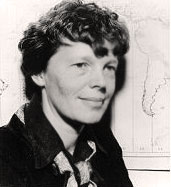
George recalls Amelia's suggestion to fly the Pacific Ocean as follows,
"One night in the autumn of 1934 she sat in golden crepe pyjamas on the "liver-toaster" (club fender) round the fireplace at Rye reading the evening paper. As I came in from the train she looked up in the way of a person thinking out loud and said, 'I want to fly the Pacific soon.' I had a briefcase and an armful of evening papers, but instead of going into the Hencoop (AE's disrespectful name for the office) to dump them I leaned against the arched doorway and said, 'You mean from San Francisco to Honolulu?' She straightened a topaz link in one of her cuffs thoughtfully, 'No, the other way; it's easier to hit a continent than an island.' 'When do you want to do it?' 'Oh, fairly soon...'"
During December of 1934 the final plans for the flight were completed and the Putnams and the Mantzes sailed for Hawaii aboard the S. S. Lurline. They were vehemently denying the suggestions of a transpacific flight to the press to avoid any negative publicity should the flight not actually happen. The basic plan for the flight was severely criticized in the press for her use of a smaller aircraft that would not hold the fuel needed for the distance and that she would cause a costly search that would risk the lives of naval pilots. Ten pilots had already lost their lives attempting the crossing. Until now, no one had attempted to make this flight solo.
The new development in this flight attempt was the use of radio. At an altitude of 12,000 feet above the Hawaiian Islands, Amelia was able to receive and transmit to Kingman, Arizona! Amelia's flight was to be the first flight in a civilian craft to carry a two-way radio telephone.
On January 11, 1935, weather conditions were right to begin her flight. Her Vega was loaded with 500 gallons of fuel, and with the extra equipment, weighed nearly 6,000 pounds. Take off went exactly as calculated and Amelia was on her way to California. For this flight she was able to keep in contact with the ground every half hour, which broke the monotony of overseas flight. Various commercial radio stations picked up her broadcasts and aired them live. This sparked a great deal of public interest in her flight. When she landed in Oakland eighteen hours later a crowd, estimated between 5,000 and 10,000, waited for her, cheering and waving flags.
By the year 1936, it seemed that all she had left to do was fly around the world, so she began to make plans to do so.
"I have a feeling that there is just about one more good flight left in my system and I hope this trip is it. Anyway, when I have finished this job, I mean to give up long-distance "stunt" flying."
Amelia's ambition to fly around the world would provide her with several major firsts. She would be the first woman to complete the flight. Also, her course was unique. Instead of seeking to create a record time by taking the shortest possible route, she planned to circle the globe at its "waist," the longest possible route. This would eliminate the necessity to compete against existing records.
On July 21, 1936, Amelia was in Los Angeles to test fly the Lockheed Electra E10 with Lockheed's test pilot, Elmer McLeod. The airplane was touted as being able to fly 4,500 miles nonstop and carrying the latest state-of-the-art equipment. On July 24, her thirty-ninth birthday, Amelia took formal delivery of the Electra.
The switch from flying the Vega to the twin engine Electra with more complicated controls was difficult. With Paul Mantz as her tutor, however, she learned to master it.
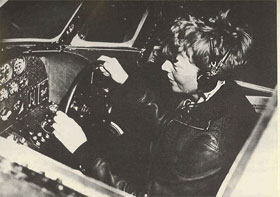
At this point in time, there was some debate over whether to attempt in-flight refueling or to find a landing strip on the Pacific Ocean between New Guinea and Hawaii. The South Pacific was poorly charted then and there were no air strips located in the areas needed. The U. S. Commerce Department was just beginning construction of an emergency landing strip and weather station on Howland Island, and it was that option that Amelia chose. There was, however, a great deal of discussion on the difficulty surrounding this decision. Howland Island is a half mile wide, two miles long and twenty five miles from Baker Island, the nearest land. It would take extraordinary navigation to locate this island when the highest point of land is eighteen feet above sea level. For this reason, Paul Noonan was selected as navigator because he had made a dozen or so trips in the area and was experience at celestial navigation from an airplane.
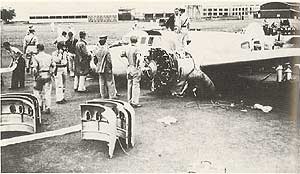
The first attempt of the flight took place in March of 1937. This route was an east to west route, beginning in Oakland, California. The Oakland to Honolulu leg of the trip set a time record, but the Electra ground looped on take off from Luke Field in Honolulu and this attempt was scrubbed.
The Electra was loaded on a ship and taken to a west coast Naval installation to be repaired (which fueled a great deal of later speculation). The second attempt was begun from Oakland on a west to east route, a reversal of the original plan, on May 21, 1937. On arrival in Miami, several repairs were needed on the Electra and the radio equipment aboard.
On June 1, 1937, a small crowd gathered in Miami well before dawn to watch the departure for California by the longest possible route--flying east.
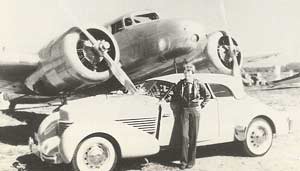
June 1, 1937 Amelia and her navigator Fred Noonan departed Miami, Florida.
They flew first to San Juan Puerto Rico, then went on to Africa and the Red sea. Next they flew to Karachi, India, setting a record. No one had flown nonstop from the Red Sea to India before.
From there, on June 17th, they flew to Calcutta, then on to Rangoon, Bangkok, Singapore and Bandoeng. In Bandoeng, repairs were made to some of the long distance instruments, which were giving them trouble. Amelia also became ill with dysentery that lasted for several days.
On June 27, Amelia and Noonan left Bandoeng for Port Darwin, Australia. There, the direction finder underwent repairs, and the parachutes were shipped home, being of no use over the Pacific.
They reached Lae, New Guinea on June 29. They had flown 22,000 miles at this point, with 7,000 more to go- all over the Pacific Ocean. Photos show Amelia looking very tired and ill.
July 2, they left Lae at precisely 00:00 hours Greenwich Mean Time.
At 07:20 hours GMT Amelia radioed a position report back to Lae, placing them on course in the vicinity of the Nukumanu Islands.
At 08:00 GMT Amelia made her last radio contact with Lae. No one saw or heard the plane after the Nukumanu Islands, so there is no precise knowledge of the aircraft's position.
At 19:30 GMT the following transmission was received by the Itasca, a U.S. Coast Guard cutter off Howland Island acting as a radio contact for Amelia.
"KHAQQ calling Itasca. We must be on you but cannot see you... gas is running low..."
At 20:14 GMT the Itasca received the last voice transmission from Amelia. The Itasca continued to transmit on all frequencies until 21:30 hours GMT. At that point, they assumed that Amelia must have ditched at sea and began a search operation.
It has been determined that the plane went down some 35-100 miles off the coast of Howland Island. President Roosevelt authorized a search that ultimately cost approximately $4 million, but Amelia and her navigator were never found. Their fate continues to be the subject of unending speculation such as:
In 1961 it was thought that the bones of Amelia and Noonan had been found on Saipan but they turned out to be those of Saipan natives.
The real story is not how she died, but how she lived.
The following links may be helpful to you to explore this fascinating woman's biography.
Ellen's PlaceThe above listing of web addresses is furnished only for your information. Forney Museum makes no claims whatsoever regarding the validity of any information you may find on these external sites. The purpose of this list is simply to provide you with some other web locations where information can be found regarding some points of interest to this topic.
Previous PageSome of the pictures and information were obtained from Twenty Hours, Forty Minutes The Sound Of Wings
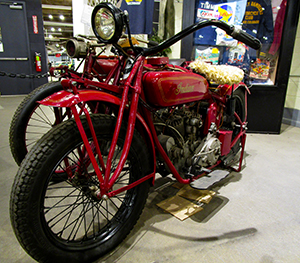
The Timme Motorcycle Collection
Come and see some incredible vintage Indian, Honda & other rare motorcycles! *Exhibits subject to change without notice*

Visit our Gallery
Make sure to visit our gallery. Our gallery features various die-cast models, art, and other artifacts related to transportation.